Family: Difference between revisions
No edit summary |
No edit summary |
||
| Line 4: | Line 4: | ||
{{Close reationships} |
{{Close reationships} |
||
| ⚫ | In [[human]] context, communication patterns in families, there are a certain set of beliefs within the family that reflect how its members should communicate and interact. These family communication patterns arise from two underlying sets of beliefs. One being conversation orientation (the degree to which the importance of communication is valued) and two, conformity orientation (the degree to which families should emphasize similarities or differences regarding attitudes, beliefs, and values).<ref>{{cite book|last=McCornack|first=Steven|title=Reflect & Relate an introduction to interpersonal communication|year=2010|publisher=Bedford/St. Martin's|location=Boston/NY|pages=369–370}}</ref> |
||
In [[human]] context, a '''family''' (from {{lang-la|familia}}) is a [[Social group|group]] of [[people]] affiliated by [[consanguinity]] (by recognized birth), [[Affinity (law)|affinity]] (by marriage), or co-residence/shared consumption (see [[Nurture kinship]]). Members of the immediate family may include a spouse, parent, brother and sister, and son and daughter. Members of the extended family may include grandparent, aunt, uncle, cousin, nephew and niece, or [[sibling-in-law]. In most societies the family is the principal institution for the socialization of children. As the basic unit for raising children, anthropologists most generally classify family organization as [[Matrifocal family|matrifocal]] (a mother and her children); conjugal (a husband, his wife, and children; also called [[nuclear family]]); [[avuncular]] (for example a brother, his sister, and her children); or [[extended family]] in which parents and children co-reside with other members of one parent's family. As a unit of [[socialization]], the family is the object of analysis for [[Kinship|anthropologists]] and [[sociology of the family|sociologists of the family]]. Sexual relations among the members are regulated by rules concerning [[incest]] such as the [[incest taboo]]. |
|||
"Family" is used metaphorically to create more inclusive categories such as [[community]], [[nation]]hood, [[global village (term)|global village]] and [[humanism]]. |
|||
[[Genealogy]] is a field which aims to trace family lineages through history. |
|||
Family is also an important economic unit studied in [[family economics]]. |
|||
==The social reproduction of the family== |
|||
[[File:ValentinianIIIfamily.jpg|thumb|A group portrait of a mother, son and daughter on glass, [[Roman Empire]], c. 250 AD]] |
|||
One of the primary functions of the family is to produce and reproduce persons, biologically and/or socially. This can occur through the sharing of material substances (such as food); the giving and receiving of care and nurture ([[nurture kinship]]); jural rights and obligations; and moral and sentimental ties.<ref name="Schneider p. 182">Schneider, David 1984 ''A Critique of the Study of Kinship''. Ann Arbor: [[University of Michigan Press]]. p. 182</ref><ref>Deleuze-Guattari (1972). Part 2, ch. 3, p. 80</ref> Thus, one's experience of one's family shifts over time. From the perspective of [[children]], the family is a "family of orientation": the family serves to locate children socially and plays a major role in their [[enculturation]] and socialization.<ref>[[John Russon|Russon, John]], (2003) ''Human Experience: Philosophy, Neurosis, and the Elements of Everyday Life'', Albany: [[State University of New York Press]]. pp. 61–68.</ref> From the point of view of the parent(s), the family is a "family of procreation," the goal of which is to produce and enculturate and socialize children.<ref>George Peter Murdoch ''Social Structure'' p. 13</ref> However, producing children is not the only function of the family; in societies with a sexual division of labor, [[marriage]], and the resulting relationship between two people, it is necessary for the formation of an economically productive [[household]].<ref>Wolf, Eric. 1982 ''Europe and the People Without History''. Berkeley: [[University of California Press]]. 92</ref><ref>Harner, Michael 1975 "Scarcity, the Factors of Production, and Social Evolution," in ''Population, Ecology, and Social Evolution'', Steven Polgar, ed. Mouton Publishers: [[the Hague]].</ref><ref>Rivière, Peter 1987 "Of Women, Men, and Manioc", ''Etnologiska Studier'' (38).</ref> |
|||
Christopher Harris notes that the western conception of family is ambiguous, and confused with the [[household]], as revealed in the different contexts in which the word is used: |
|||
<blockquote>"We have seen that people can refer to their relatives as 'the family.' 'All the family turned up for the funeral.... But of course, my brother didn't bring his family along - they're much too young.' Here the reference is to the offspring (as distinct from 'all' the family). The neighbors were very good, too. 'The Jones came, and their two children. It was nice, the whole family turning up like that.' Here the usage is more restricted than 'relatives' or 'his relatives,' but includes just both parents and offspring. 'Of course, the children will be leaving home soon. It's always sad to see the family break up like that.' Here the reference is not only to parents and children but to their co-residence, that is, to the household."<ref>{{cite book|last=Harris|first=Christopher|title=The Family and Industrial Society|year=1983|publisher=George Allen Unwin|location=London|page=30}}</ref></blockquote> |
|||
Olivia Harris states this confusion is not accidental, but indicative of the familial ideology of capitalist, western countries that pass social legislation that insists members of a nuclear family should live together, and that those not so related should not live together; despite the ideological and legal pressures, a large percentage of families do not conform to the ideal nuclear family type.<ref>{{cite book|title=Of Marriage and the Market: Women's Subordination Internationally and its Lessons|publisher=Routledge|location=London|page=138|author=Olivia Harris|authorlink=Households as natural units|editor=Kate Young, Carol Wolkowitz, and Roslyn McCullagh}}</ref> |
|||
==Family types== |
|||
[[File:Bundesarchiv Bild 183-A0808-0008-001, Berlin, Passanten.jpg|thumb|A mother with her children, Berlin, Germany, 1962]] |
|||
[[File:Wm._Riley_Blankinship,_miner,_with_his_children._Koppers_Coal_Division,_Kopperston_Mine,_Kopperston,_Wyoming_County..._-_NARA_-_540984.jpg|thumb|A miner with his children, West Virginia, 1946]] |
|||
The diverse data coming from [[ethnography]], history, law and social statistics, establish that the human family is an institution and not a biological fact found on the natural relationship of [[consanguinity]].<ref name="Lacan3801">Lacan 1938–2001, pp. 24–25, 56</ref><ref name="FugierPascal226">Fugier Pascal, 2007, p.226-8</ref> The different types of families occur in a wide variety of settings, and their specific functions and meanings depend largely on their relationship to other social institutions. Although the concept of consanguinity originally referred to relations by "blood," [[cultural anthropologist]]s have argued that one must understand the idea of "blood" metaphorically and that many societies understand family through other concepts rather than through [[genetic distance]].<ref name="Schneider p. 182"/> [[Sociologist]]s have a special interest in the function and status of these forms in stratified (especially [[Capitalism|capitalist]]) societies. |
|||
According to the work of scholars [[Max Weber]], [[Alan Macfarlane]], [[Steven Ozment]], [[Jack Goody]] and [[Peter Laslett]], the huge transformation that led to modern marriage in Western democracies was "fueled by the religio-cultural value system provided by elements of Judaism, early Christianity, Roman Catholic canon law and the Protestant Reformation".<ref>{{cite web |url=http://www.religion-online.org/showarticle.asp?title=3322 |publisher=Religion-online.org |title=The Collapse of Marriage by Don Browning – The Christian Century |date=February 7, 2006 |pages=24–28 |accessdate=2007-07-10}}</ref> |
|||
Much sociological, [[historical]] and [[cultural anthropology|anthropological]] research dedicates itself to the understanding of this variation, and of changes in the family that form over time. ''Times have changed; it is more acceptable and encouraged for mothers to work and fathers to spend more time at home with the children. The way roles are balanced between the parents will help children grow and learn valuable life lessons. There is great importance of communication and equality in families, in order to avoid role strain. '' <ref>{{cite web|author=Levitan, Sara|date=2010|title=Working wives and mothers: what happens to family life?|url=http://www.bls.gov/opub/mlr/1981/09/art4full.pdf|accessdate=January 8, 2014}}</ref> |
|||
===Conjugal (nuclear) family=== |
|||
The term "[[nuclear family]]" is commonly used, especially in the United States, to refer to conjugal families. A "conjugal" family includes only the husband, the wife, and unmarried children who are not of age.<ref>[http://oregonstate.edu/instruct/anth370/gloss.html Oregonstate.edu], Nuclear family – "A family group consisting of wife, husband (or one of these) and dependent children." – Definitions of Anthropological Terms – Anthropological Resources – (Court Smith) Department of Anthropology, [[Oregon State University]]</ref> Sociologists distinguish between conjugal families (relatively independent of the kindred of the parents and of other families in general) and nuclear families (which maintain relatively close ties with their kindred). |
|||
===Matrifocal family=== |
|||
A "matrifocal" family consists of a [[mother]] and her children. Generally, these children are her biological offspring, although adoption of children is a practice in nearly every society. This kind of family is common where women have the resources to rear their children by themselves, or where men are more mobile than women. |
|||
===Extended family=== |
|||
[[File:Basankusu - typical fired brick house.jpg|thumb|left|A family from Basankusu, [[Democratic Republic of the Congo]], in front of a typical fired-brick, palm thatched house]] |
|||
The term "[[extended family]]" is also common, especially in United States. This term has two distinct meanings. First, it serves as a synonym of "consanguinal family" (consanguine means "of the same blood"). Second, in societies dominated by the conjugal family, it refers to "[[Kinship|kindred]]" (an egocentric network of relatives that extends beyond the domestic group) who do not belong to the conjugal family. These types refer to ideal or normative structures found in particular societies. Any society will exhibit some variation in the actual composition and conception of families. |
|||
===Blended family=== |
|||
The term ''blended family'' or ''[[stepfamily]]'' describes families with mixed parents: one or both parents remarried, bringing children of the former family into the new family.<ref>[http://www.blendedandblessed.com/BlendedBlog.dsp Blended and Blessed] – Encouraging Step-Families, blendedandblessed.com{{Dead link|date=January 2009}}</ref> Also in sociology, particularly in the works of social psychologist [[Michael Lamb (psychologist)|Michael Lamb]],<ref>{{cite web|url=http://www.sdp.cam.ac.uk/contacts/staff/profiles/mlamb.html |title=Department of Social and Developmental Psychology: PPSIS Faculty, Academic Profile |publisher=Sdp.cam.ac.uk |accessdate=2011-03-26}}</ref> ''traditional family'' refers to "a middleclass family with a bread-winning father and a stay-at-home mother, married to each other and raising their biological children," and ''nontraditional'' to exceptions from this rule. Most of the US households are now non-traditional under this definition.<ref>[http://www.glad.org/uploads/docs/cases/gill-v-office-of-personnel-management/2009-11-17-doma-aff-lamb.pdf Civil Action No. 1:09-cv-10309] paragraph 17</ref> |
|||
| ⚫ | In |
||
==Kinship terminology== |
==Kinship terminology== |
||
Revision as of 07:16, 5 August 2014

{{Aology of kinship} {{Close reationships}
In human context, communication patterns in families, there are a certain set of beliefs within the family that reflect how its members should communicate and interact. These family communication patterns arise from two underlying sets of beliefs. One being conversation orientation (the degree to which the importance of communication is valued) and two, conformity orientation (the degree to which families should emphasize similarities or differences regarding attitudes, beliefs, and values).[1]
Kinship terminology
Degrees of kinship

A first-degree relative is one who shares 50% of your DNA, such as a full sibling, parent or progeny.
| Kinship | Closeness | Genetic overlap |
|---|---|---|
| Identical twins | not applicable | 99.9% |
| Full sibling | first-degree | 50% |
| Parent | first-degree | 50% |
| Offspring/progeny | first-degree | 50% |
| Half-sibling | second-degree | 25% |
| Grandmother/grandfather | second-degree | 25% |
| Aunt/uncle | second-degree | 25% |
| Niece/nephew | second-degree | 25% |
| First cousin | third-degree | 12.5% |
| Half-aunt, half-uncle | third-degree | 12.5% |
| Half-niece/half-nephew | third-degree | 12.5% |
| First cousin once removed | fourth-degree | 6.25% |
| Second cousin | fifth-degree | 3.125% |
| Third cousin | seventh-degree | 0.781% |
Terminologies
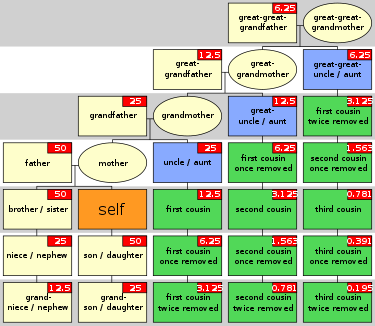
Anthropologist Lewis Henry Morgan (1818–1881) performed the first survey of kinship terminologies in use around the world. Although much of his work is now considered dated, he argued that kinship terminologies reflect different sets of distinctions. For example, most kinship terminologies distinguish between sexes (the difference between a brother and a sister) and between generations (the difference between a child and a parent). Moreover, he argued, kinship terminologies distinguish between relatives by blood and marriage (although recently some anthropologists have argued that many societies define kinship in terms other than "blood").
Morgan made a distinction between kinship systems that use classificatory terminology and those that use descriptive terminology. Classificatory systems are generally and erroneously understood to be those that "class together" with a single term relatives who actually do not have the same type of relationship to ego. (What defines "same type of relationship" under such definitions seems to be genealogical relationship. This is problematic given that any genealogical description, no matter how standardized, employs words originating in a folk understanding of kinship.) What Morgan's terminology actually differentiates are those (classificatory) kinship systems that do not distinguish lineal and collateral relationships and those (descriptive) kinship systems that do. Morgan, a lawyer, came to make this distinction in an effort to understand Seneca inheritance practices. A Seneca man's effects were inherited by his sisters' children rather than by his own children.[2] Morgan identified six basic patterns of kinship terminologies:
- Hawaiian: only distinguishes relatives based upon sex and generation.
- Sudanese: no two relatives share the same term.
- Eskimo: in addition to distinguishing relatives based upon sex and generation, also distinguishes between lineal relatives and collateral relatives.
- Iroquois: in addition to sex and generation, also distinguishes between siblings of opposite sexes in the parental generation.
- Crow: a matrilineal system with some features of an Iroquois system, but with a "skewing" feature in which generation is "frozen" for some relatives.
- Omaha: like a Crow system but patrilineal.
Family roles
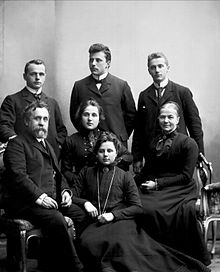
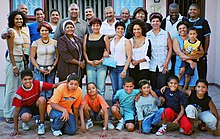

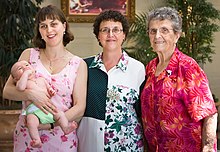
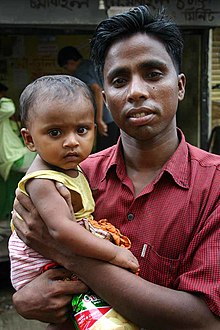
Most Western societies employ Eskimo kinship terminology.[citation needed] This kinship terminology commonly occurs in societies based on conjugal (or nuclear) families, where nuclear families have a degree of relative mobility. Members of the nuclear use descriptive kinship terms:
- Father: a male parent
- Mother: a female parent
- Son: a male child of the parent(s)
- Daughter: a female child of the parent(s)
- Brother: a male sibling
- Sister: a female sibling
- Grandfather: the father of a parent
- Grandmother: the mother of a parent
- Cousins: two people who share at least one grandparent in common, but neither the same parents.
Such systems generally assume that the mother's husband is also the biological father. In some families, a woman may have children with more than one man or a man may have children with more than one woman. The system refers to a child who shares only one parent with another child as a "half-brother" or "half-sister". For children who do not share biological or adoptive parents in common, English-speakers use the term "stepbrother" or "stepsister" to refer to their new relationship with each other when one of their biological parents marries one of the other child's biological parents. Any person (other than the biological parent of a child) who marries the parent of that child becomes the "stepparent" of the child, either the "stepmother" or "stepfather". The same terms generally apply to children adopted into a family as to children born into the family.
Typically, societies with conjugal families also favor neolocal residence; thus upon marriage a person separates from the nuclear family of their childhood (family of orientation) and forms a new nuclear family (family of procreation). However, in western society the single parent family has been growing more accepted and has begun to make an impact on culture. Single parent families are more commonly single mother families than single father. These families sometimes face difficult issues besides the fact that they have to rear their children on their own, for example low income making it difficult to pay for rent, child care, and other necessities for a healthy and safe home. Members of the nuclear families of members of one's own (former) nuclear family may class as lineal or as collateral. Kin who regard them as lineal refer to them in terms that build on the terms used within the nuclear family:
- Grandparent
- Grandfather: a parent's father
- Grandmother: a parent's mother
- Grandchild
- Grandson: a child's son
- Granddaughter: a child's daughter
For collateral relatives, more classificatory terms come into play, terms that do not build on the terms used within the nuclear family:
- Uncle: father's brother, mother's brother, father's sister's husband, mother's sister's husband
- Aunt: father's sister, mother's sister, father's brother's wife, mother's brother's wife
- Nephew: brother's son, sister's son, husband's brother's son, husband's sister's son, wife's brother's son, wife's sister's son
- Niece: brother's daughter, sister's daughter, husband's brother's daughter, husband's sister's daughter, wife's brother's daughter, wife's sister's daughter
When additional generations intervene (in other words, when one's collateral relatives belong to the same generation as one's grandparents or grandchildren), the prefixes "great-" or "grand-" modifies these terms. Also, as with grandparents and grandchildren, as more generations intervene the prefix becomes "great-grand-," adding an additional "great-" for each additional generation. Most collateral relatives have never had membership of the nuclear family of the members of one's own nuclear family.
- Cousin: the most classificatory term; the children of uncles or aunts. One can further distinguish cousins by degrees of collaterality and by generation. Two persons of the same generation who share a grandparent count as "first cousins" (one degree of collaterality); if they share a great-grandparent they count as "second cousins" (two degrees of collaterality) and so on. If two persons share an ancestor, one as a grandchild and the other as a great-grandchild of that individual, then the two descendants class as "first cousins once removed" (removed by one generation); if they shared ancestor figures as the grandparent of one individual and the great-great-grandparent of the other, the individuals class as "first cousins twice removed" (removed by two generations), and so on. Similarly, if they shared ancestor figures as the great-grandparent of one person and the great-great-grandparent of the other, the individuals class as "second cousins once removed". Hence one can refer to a "third cousin once removed upwards."
Cousins of an older generation (in other words, one's parents' first cousins), although technically first cousins once removed, are often classified with "aunts" and "uncles." Similarly, a person may refer to close friends of one's parents as "aunt" or "uncle," or may refer to close friends as "brother" or "sister," using the practice of fictive kinship. English-speakers mark relationships by marriage (except for wife/husband) with the tag "-in-law." The mother and father of one's spouse become one's mother-in-law and father-in-law; the female spouse of one's child becomes one's daughter-in-law and the male spouse of one's child becomes one's son-in-law. The term "sister-in-law" refers to three essentially different relationships, either the wife of one's sibling, or the sister of one's spouse, or, in some uses, the wife of one's spouse's sibling. "Brother-in-law" expresses a similar ambiguity. The terms "half-brother" and "half-sister" indicate siblings who share only one biological or adoptive parent.
History of theories of the family
Social Darwinists
Early scholars of family history applied Darwin's biological theory of evolution in their theory of evolution of family systems.[3] American anthropologist Lewis H. Morgan published Ancient Society in 1877 based on his theory of the three stages of human progress from Savagery through Barbarism to Civilization.[4] Morgan's book was the "inspiration for Friedrich Engels' book" The Origin of the Family, Private Property and the State published in 1884.[5]
Engels expanded Morgan's hypothesis that economical factors caused the transformation of primitive community into a class-divided society.[6] Engels' theory of resource control, and later that of Karl Marx, was used to explain the cause and effect of change in family structure and function. The popularity of this theory was largely unmatched until the 1980s, when other sociological theories, most notably structural functionalism, gained acceptance.
The nuclear family in industrial society

Contemporary society generally views the family as a haven from the world, supplying absolute fulfillment. Zinn and Eitzen discuss the image of the "family as haven [...] a place of intimacy, love and trust where individuals may escape the competition of dehumanizing forces in modern society".[8] During industrialization, "[t]he family as a repository of warmth and tenderness (embodied by the mother) stands in opposition to the competitive and aggressive world of commerce (embodied by the father). The family's task was to protect against the outside world."[9] However, Zinn and Eitzen note, "The protective image of the family has waned in recent years as the ideals of family fulfillment have taken shape. Today, the family is more compensatory than protective. It supplies what is vitally needed but missing in other social arrangements."[10]
"The popular wisdom", according to Zinn and Eitzen, sees the family structures of the past as superior to those today, and families as more stable and happier at a time when they did not have to contend with problems such as illegitimate children and divorce. They respond to this, saying, "there is no golden age of the family gleaming at us in the far back historical past."[11] "Desertion by spouses, illegitimate children, and other conditions that are considered characteristics of modern times existed in the past as well."[12]
The postmodern family
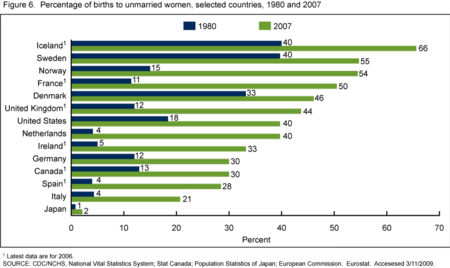
Others argue that whether or not one views the family as "declining" depends on one's definition of "family". Married couples have dropped below half of all American households. This drop is shocking from traditional forms of the family system. Only a fifth of households were following traditional ways of having married couples raising a family together.[14] In the Western World, marriages are no longer arranged for economic, social or political gain, and children are no longer expected to contribute to family income. Instead, people choose mates based on love. This increased role of love indicates a societal shift toward favoring emotional fulfilment and relationships within a family, and this shift necessarily weakens the institution of the family.[15]
Margaret Mead considers the family as a main safeguard to continuing human progress. Observing, "Human beings have learned, laboriously, to be human", she adds: "we hold our present form of humanity on trust, [and] it is possible to lose it" ... "It is not without significance that the most successful large-scale abrogations of the family have occurred not among simple savages, living close to the subsistence edge, but among great nations and strong empires, the resources of which were ample, the populations huge, and the power almost unlimited"[16]
Oedipal family model and fascism
The model, common in the western societies, of the family triangle, husband-wife-children isolated from the outside, is also called the oedipal model of the family, and it is a form of patriarchal family. Many philosophers and psychiatrists have analyzed such a model. In such a family, they argue, the young develop in a perverse relationship, wherein they learn to love the same person who beats and oppresses them. They believe that young children grow up and develop loving a person who is oppressing them physically or mentally, and that these children are not taught in a way that will raise affectionate children.[17] Such philosophers claim that the family therefore constitutes the first cell of the fascist society, as the children will carry this attitude of love for oppressive figures in their adult life.[18][19] They claim that fathers torment their sons.[20][21] Deleuze and Guattari, in their analysis of the dynamics at work within a family, "track down all varieties of fascism, from the enormous ones that surround and crush us to the petty ones that constitute the tyrannical bitterness of our everyday lives".[18]
As it has been explained by Deleuze, Guattari and Foucault, as well as other philosophers and psychiatrists such as Laing and Reich, the patriarchal-family conceived in the West tradition serves the purpose of perpetuating a propertarian and authoritarian society.[22] The child grows according to the oedipal model, which is typical of the structure of capitalist societies,[23][24] and he becomes in turn owner of submissive children and protector of the woman.[21][25][26][27][28]
As the young undergoes physical and psychological repression from someone for whom they develop love, they develop a loving attitude towards authority figures. They will bring such attitude in their adult life, when they will desire social repression and will form docile subjects for society.[22] Michel Foucault, in his systematic study of sexuality, argued that rather than being merely repressed, the desires of the individual are efficiently mobilized and used,[18] to control the individual, alter interpersonal relationships and control the masses. Foucault believed organized religion, through moral prohibitions, and economic powers, through advertising, make use of unconscious sex drives. Dominating desire, they dominate individuals.[29] According to the analysis of Michel Foucault, in the west:
the [conjugal] family organization, precisely to the extent that it was insular and heteromorphous with respect to the other power mechanisms, was used to support the great "maneuvers" employed for the Malthusian control of the birthrate, for the populationist incitements, for the medicalization of sex and the psychiatrization of its nongenital forms.
— Michel Foucault, The History of Sexuality vol I, chap. IV, sect. Method, rule 3, p. 99
Domestic violence
Domestic violence (DV) is violence that happens within the family. The legal and social understanding of the concept of DV differs by culture. The definition of the term "domestic violence" varies, depending on the context in which it is used.[30] It may be defined differently in medical, legal, political or social contexts. The definitions have varied over time, and vary in different parts of the world.
The Convention on preventing and combating violence against women and domestic violence states that:[31]
- " “domestic violence” shall mean all acts of physical, sexual, psychological or economic violence that occur within the family or domestic unit or between former or current spouses or partners, whether or not the perpetrator shares or has shared the same residence with the victim".
Forced and child marriages are practiced in certain regions of the world, particularly in Asia and Africa, and these types of marriages are associated with a high rate of DV.[32][33][34][35]
Size
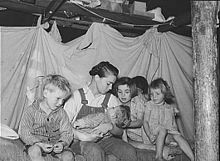
Natalism is the belief that human reproduction is the basis for individual existence, and therefore promotes having large families. Many religions, e.g., Islam, Christianity and Judaism,[36] encourage their followers to procreate and have many children, however many of them also propound stewardship and responsibility to care for the environment and society. In recent times, however, there has been an increasing amount of family planning and a following decrease in the total fertility rate in many parts of the world, in part due to improvements in health care, concerns of overpopulation, decreasing need for manual labor and increasing cost of raising a child as workers need to be more skilled. Many countries with population decline offer incentives for people to have large families as a means of national efforts to reverse declining populations.
Family rights and laws
Reproductive rights
Reproductive rights are legal rights and freedoms relating to reproduction and reproductive health. These include the right to decide on issues regarding the number of children born, family planning, contraception, and private life, free from coercion and discrimination; as well as the right to access health services and adequate information.[37][38][39] [40] According to UNFPA, reproductive rights "include the right to decide the number, timing and spacing of children, the right to voluntarily marry and establish a family, and the right to the highest attainable standard of health, among others".[41]
Mothers' rights
Mothers' rights movements focus on maternal health, workplace issues such as labor rights, breastfeeding, and rights in family law.
Fathers' rights
The fathers' rights movement is a movement whose members are primarily interested in issues related to family law, including child custody and child support, that affect fathers and their children.[42]
Children's rights
Children's rights are the human rights of children, with particular attention to the rights of special protection and care afforded to minors, including their right to association with both parents, their right to human identity, their right to be provided in regard to their other basic needs, and their right to be free from violence and abuse.[43][44][45]
Marriage rights
Each jurisdiction has its own marriage laws. These laws differ significantly from country to country; and these laws are often controversial. Areas of controversy include women's rights as well as same sex marriage.
Work-family balance
Work-family balance is a concept involving proper prioritizing between work/career and family life. It includes issues relating to the way how work and families intersect and influence each other. At a political level, it is reflected through policies such maternity leave and paternity leave.
Health
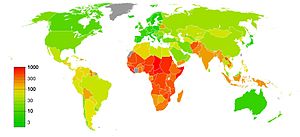
Family medicine
Family medicine is a medical specialty devoted to comprehensive health care for people of all ages; it is based on knowledge of the patient in the context of the family and the community, emphasizing disease prevention and health promotion.[47] The importance of family medicine is being increasingly recognized.[48]
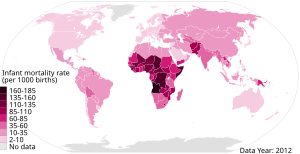
Maternal mortality
Maternal mortality or maternal death is defined by WHO as "the death of a woman while pregnant or within 42 days of termination of pregnancy, irrespective of the duration and site of the pregnancy, from any cause related to or aggravated by the pregnancy or its management but not from accidental or incidental causes."[50] Historically, maternal mortality was a major cause of women's death. In recent decades, advances in healthcare have resulted in rates of maternal mortality having dropped dramatically, especially in Western countries. Maternal mortality however remains a serious problem in many African and Asian counties.[51][52]
Infant and child mortality
Infant mortality is the death of a child less than one year of age. Child mortality is the death of a child before the child's fifth birthday. Like maternal mortality, infant and child mortality were common throughout history, but have decreased significantly in modern times.[53][54]
Criticism of family
Certain social scientists have advocated the abolition of the family. An early opponent of the family was Socrates whose position was outlined by Plato in The Republic.[55] In Book 5 of The Republic, Socrates tells his interlocutors that a just city is one in which citizens have no family ties.[56][57]
The family being such a deep-rooted and much-venerated institution, few intellectuals have ventured to speak against it. Familialism has been atypically defined as a “social structure where … a family's values are held in higher esteem than the values of the individual members of the family.”[58] Favoritism granted to relatives regardless of merit is called nepotism.
The Russian-American rationalist and individualist philosopher, novelist and playwright Ayn Rand compared partiality towards consanguinity with racism, as a small-scale manifestation of the latter.[59] “The worship of the family is merely racism, like a crudely primitive first installment on the worship of the tribe. It places the accident of birth above a man's values and duty to the tribe above a man's right to his own life.”[60] Additionally, she spoke in favor of childfree lifestyle, while following it herself.[59]
The British social critic, poet, mountaineer and occultist Aleister Crowley censured the institution of family in his works: “Horrid word, family! Its very etymology accuses it of servility and stagnation. / Latin, famulus, a servant; Oscan, Faamat, he dwells. … [T]hink what horrid images it evokes from the mind. Not only Victorian; wherever the family has been strong, it has always been an engine of tyranny. Weak members or weak neighbours: it is the mob spirit crushing genius, or overwhelming opposition by brute arithmetic. … In every Magical, or similar system, it is invariably the first condition which the Aspirant must fulfill: he must once and for all and for ever put his family outside his magical circle.”[61]
The American journalist Marty Nemko considers family to be overrated. “Politicians, clerics, and just plain folks extol family as our most important institution. / I believe family is overrated. So many people suffer inordinately from family. … / Millions of people don't even speak with a family member. Millions more spend years and fortunes on therapists, trying to undo the ills that family perpetrated on them. / All this shouldn’t be surprising. After all, unlike with friends, we are placed in our family of origin at random, with no say in the matter.”[62]
In the Bible
In the gospels of the New Testament Mark 3:31-35 and Matthew 23:9, it is written, “There came then [Jesus'] brethren and his mother, and, standing without, sent unto him, calling him. / And the multitude sat about him, and they said unto him, Behold, thy mother and thy brethren without seek for thee. / And he answered them, saying, Who is my mother, or my brethren? / And he looked round about on them which sat about him, and said, Behold my mother and my brethren! / For whosoever shall do the will of God, the same is my brother, and my sister, and mother. … / And call no man your father upon the earth: for one is your Father, which is in heaven.”
Jesus Christ is also recorded in the Bible as saying,
If any man come to me, and hate not his father, and mother, and wife, and children, and brethren, and sisters, yea, and his own life also, he cannot be my disciple” (Luke 14:26)
, as well as “Then Peter began to say unto him, Lo, we have left all, and have followed thee. / And Jesus answered and said, Verily I say unto you, There is no man that hath left house, or brethren, or sisters, or father, or mother, or wife, or children, or lands, for my sake, and the gospel's, / But he shall receive an hundredfold now in this time, houses, and brethren, and sisters, and mothers, and children, and lands, with persecutions; and in the world to come eternal life.” (Mark 10:29-30).
Such passages abound: Matthew 8-21, 10:34-36, 12:47-49, 15:4-7; Luke 2:46-49, 8:20-21, 9:59-62, 11:27-28, 12:51-53.
See also
Notes and references
- ^ McCornack, Steven (2010). Reflect & Relate an introduction to interpersonal communication. Boston/NY: Bedford/St. Martin's. pp. 369–370.
- ^ Tooker, Elisabeth. "Another View of Morgan on Kinship." Current Anthropology 20, no. 1 (March 1979): 131–134.
- ^ "Sociology/Founding the discipline". Encyclopædia Britannica. Retrieved 2009-07-26.
- ^ Morgan 1877
- ^ "Cultural Anthropology". Encyclopædia Britannica. Retrieved 2009-07-22.
- ^ "The Marxists Internet Archive". Retrieved 2009-07-17.
- ^ Williams, Brian; Stacey C. Sawyer; Carl M. Wahlstrom (2005). Marriages, Families & Intimate Relationships. Boston, MA: Pearson. 0-205-36674-0.
- ^
Zinn, Maxine Baca; D. Stanley Eitzen (2002). Diversity in families (6 ed.). Allyn and Bacon. p. 557. ISBN 978-0-205-33522-0. Retrieved 2012-01-06.
This 'family as haven' image of a refuge from an impersonal world characterizes the family as a place of intimacy, love, and trust in which individuals may escape the competition of dehumanizing forces in modern society. Christopher Lasch (1977:8) has named this image a 'haven in a heartless world' and described it as a glorification of private life made necessary by the deprivations experienced in the public world.
- ^ Zinn and Eitzen (1987) Diversity in American families, p. 3
- ^ Zinn and Eitzen (1987) Diversity in American families, p. 3
- ^ Zinn and Eitzen (1987) Diversity in American families, p. 8
- ^ Zinn and Eitzen (1987) Diversity in American families, p. 8
- ^ "Changing Patterns of Nonmarital Childbearing in the United States". CDC/National Center for Health Statistics. May 13, 2009. Retrieved September 24, 2011.
- ^ Tavernise, Sabrina (2011). "Married Couples Are No Longer a Majority, Census Finds". Retrieved January 8, 2014.
- ^ Coontz, Stephanie. 2005. Marriage, A History: How Love Conquered Marriage. New York: Viking/Penguin Books.
- ^ Male and Female, New York, 1949. pp. 193-194
- ^ "About Family". Word Press. 31 March 2012. Retrieved January 8, 2014.
- ^ a b c Foucault (1984) Preface to the American edition of Anti-Œdipus pp. xiii–xvi.
- ^ Wilhelm Reich (1933) The Mass Psychology of Fascism, Chapter V, The Sex-Economic Presuppositions of the Authoritarian Family
- ^ John Phillips Structural Linguistics and Anthropology, courses.nus.edu.sg
- ^ a b Wilhelm Reich [1936] The Sexual Revolution, Chapter V, The compulsive family as educational apparatus, pp. 71–77
- ^ a b Deleuze-Guattari (1972). Part 2, ch. 7, pp. 129–31
- ^ Cite error: The named reference
Lacan3801was invoked but never defined (see the help page). - ^ Cite error: The named reference
FugierPascal226was invoked but never defined (see the help page). - ^ Template:It icon Gianni Vattimo Tutto in famiglia (article appeared on Il Manifesto October 15, 2004), feltrinelli.it Template:It icon
- ^ Template:It icon Luttazzi, Daniele Bollito misto con mostarda (2005) p. 262, books.google.com
- ^ Theodor W. Adorno and Stephen Crook Adorno ISBN 0-415-27099-5, p. 9-10, books.google.com
- ^ E. James Anthony, The Family and the Psychoanalytic Process in Children (1980). Psychoanalytic Study of the Child, 35:3–34, pep-web.org
- ^ Foucault, The History of Sexuality
- ^ https://www.childwelfare.gov/systemwide/laws_policies/statutes/defdomvio.cfm
- ^ http://conventions.coe.int/Treaty/EN/Treaties/Html/210.htm
- ^ http://www.hrw.org/news/2013/06/14/q-child-marriage-and-violations-girls-rights
- ^ http://www.who.int/mediacentre/news/releases/2013/child_marriage_20130307/en/
- ^ http://www.bbc.co.uk/worldservice/people/features/ihavearightto/four_b/casestudy_art16.shtml
- ^ http://www.plan-uk.org/early-and-forced-marriage/
- ^ Joys of A Large Family, by Rebbetzin Faige Twerski. angelfire.com
- ^ http://www.who.int/hhr/activities/GRR/en/
- ^ http://www.unfpa.org/swp/2005/english/ch3/ch3_box9.htm
- ^ http://www.who.int/reproductivehealth/topics/gender_rights/sexual_health/en/
- ^ http://www.amnesty.org/en/campaigns/stop-violence-against-women/issues/implementation-existing-laws/srr
- ^ http://www.unfpa.org/rights/rights.htm
- ^ Collier & Sheldon, 2006, p. 1–26.
- ^ .http://www.unicef.org/crc/index_protecting.html
- ^ http://www.hrw.org/topic/childrens-rights
- ^ http://www.amnesty.org/en/children
- ^ Country Comparison: Maternal Mortality Rate in The CIA World Factbook.
- ^ http://familymedicine.bsd.uchicago.edu/OurDepartment/WhatIsFamilyMedicine
- ^ http://www.who.int/dg/speeches/2013/family_medicine_20130626/en/
- ^ Infant Mortality Rates in 2012, UNICEF, 2013.
- ^ http://www.who.int/healthinfo/statistics/indmaternalmortality/en/
- ^ http://www.who.int/healthinfo/statistics/indmaternalmortality/en/
- ^ http://www.who.int/mediacentre/factsheets/fs348/en/
- ^ http://www.who.int/gho/child_health/mortality/neonatal_infant_text/en/
- ^ http://www.who.int/mediacentre/factsheets/fs178/en/
- ^ Abolition of the Family for the Guardians and the Use of War (457b-471c)
- ^ http://www.sparknotes.com/philosophy/republic/section5.rhtml
- ^ http://www.litcharts.com/lit/the-republic/book-5
- ^ “Your Dictionary (the Dictionary You Can Understand)”. Dictionary definitions. familialism.
- ^ a b Heller, Anne C. (2009). Ayn Rand and the World She Made. New York: Doubleday. pp. 320–321. ISBN 978-0-385-51399-9. OCLC 2290274371.
{{cite book}}: Invalid|ref=harv(help) Said in one of the lectures Ayn Rand delivered. - ^ Said in one of the public lectures Ayn Rand delivered
- ^ Crowley, Aleister. Magick Without Tears. Chapter LII “Family: Public Enemy No. 1”. Falcon Press, 1982. ISBN 0-941404-17-X
- ^ Nemko, Marty. "Family is Overrated. September 12, 2008
Bibliography
- Chevallier, Denis. "Famille et parenté: une bibliographie". Terrain (in French). Retrieved January 8, 2014.
- Forbes, Scott, A Natural History of Families, (Princeton, NJ: Princeton University Press, 2005), ISBN 0-691-09482-9
- Foucault, Michel (1978). The History of Sexuality: Volume I: An Introduction. (New York: Vintage Books). ISBN 978-0-679-72469-8
- Gilroy, Paul Identity Belonging and the Critique of Pure Sameness in Gilroy, Paul (2000) Against Race: Imagining Political Culture Beyond the Color Line, (Cambridge, Mass.: Belknap Press of Harvard University Press), Ch. I.3, pp. 97–133
- Goody, Jack The Development of the Family and Marriage in Europe (Cambridge University Press, 1980); translated into Spanish, French, Italian, Portuguese.
- Mock, Douglas W., More Than Kin and Less Than Kind, (Belknap Press, 2004), ISBN 0-674-01285-2
- Schneider, David M., American Kinship: a cultural approach (Chicago: University of Chicago Press, 1980).
- Tabak I., Mazur J., Granado M.C., Örkenyi Á., Zaborskis A., Aasvee K. & Moreno C. (2012). "Examining trends in parent-child communication in Europe over 12 years". The Journal of Early Adolescence. pp. 26–54. doi:10.1177/0272431611419509. Retrieved January 8, 2014.
{{cite web}}: CS1 maint: multiple names: authors list (link) - Ommer, Uwe. 1000 Families: das Familienalbum des Planeten Erde. Taschen, Cologne 2002, ISBN 3-8228-2264-7
External links
select an article title from: Wikisource:1911 Encyclopædia Britannica
- Family database, OECD,
- Family Research Laboratory, unh.edu
- Family evolution and contemporary social transformations, seres.fcs.ucr.ac.cr (Estación de Economía Política)
- Family Facts: Social Science Research on Family, Society & Religion (a Heritage Foundation site). familyfacts.org
- Families Australia – independent peak not-for-profit organisation. familiesaustralia.org.au
- FamilyPlatform – A consortium of 12 organisations providing input into the European Union's Socio-Economic and Humanities Research Agenda on Family Research and Family Policies.
- Unitedfamilies.org, International organisation
- UN.org, Families and Development
- Family, marriage and "de facto" unions, Vatican.va
Template:Articles of the Universal Declaration of Human Rights
